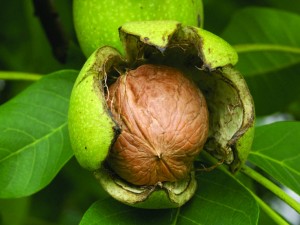 The Walnut Tree has been highly prized for its beauty and treasured since ancient times; spanning thousands of years. It produces a one seeded fruit, called a kernel that is known as the delicious walnut. This tree belongs to the Juglans family, which includes cashews, Brazil nuts, hazelnuts, pecans, macadamia nuts, pine nuts, pecans and pistachios. The walnut tree can live 150 to possibly 300 years or more. The tree takes approximately four years until it produces its first major crop. The kernel resembles a brain; attributed to its two halves of convoluted surfaces inside its shell.
The Walnut Tree has been highly prized for its beauty and treasured since ancient times; spanning thousands of years. It produces a one seeded fruit, called a kernel that is known as the delicious walnut. This tree belongs to the Juglans family, which includes cashews, Brazil nuts, hazelnuts, pecans, macadamia nuts, pine nuts, pecans and pistachios. The walnut tree can live 150 to possibly 300 years or more. The tree takes approximately four years until it produces its first major crop. The kernel resembles a brain; attributed to its two halves of convoluted surfaces inside its shell.
The Romans, circa the 4th century CE, established walnut trees in many areas of Europe. Black walnuts and white walnuts are indigenous to North America and were a food source for Native Americans. The black walnut has a pungent distinctive flavor and has the hardest shell. The white walnut is sweeter with an oilier taste. The most popular type in the US is the English walnut, also known as the Persian walnut; it has a thinner shell and can be broken easily with a nutcracker. Originally from India and regions around the Caspian Sea, it became known as the English walnut, because it is believed, it was brought to America by English merchants.
The health benefits of walnuts should outweigh the fear of it being fattening; no pun intended. Consuming as little as 7 whole nuts a day are all that is needed to endow significant results. Walnuts are an excellent source for anti-oxidants and anti-inflammatory nutrients. Anti-oxidants protect the cells in your body from free radicals; causing damage that can occur from a variety of toxins, including smoking, pesticides and chemicals. Anti-oxidants may lower the risk of infections and some kinds of cancer. Inflammation is caused by injuries resulting from any kind of assault on the body and is a natural process whereby the body tries to heal itself. Anti-inflammatories reduce pain by reducing the inflammation that causes the pain. Unchecked, chronic inflammation can cause serious illness including heart disease, stroke, cancer, diabetes, sleep and mood disorders, arthritis and Alzheimer’s. Chronic inflammation has also been linked to obesity.
Walnuts provide unusually high levels of the anti-oxidant, Gamma-Tocopherol, an isomer of vitamin E. Vitamin E is one of the essential nutrients required by human beings. Among its attributes are that it is good for the skin, eyes and the immune system, and may slow the progress of dementia. The phytonutrients in walnuts provides both anti-inflammatory and anti-oxidants that may protect against metabolic syndrome, cardiovascular problems and type 2 diabetes. Another essential nutrient found in walnuts is the anti-inflammatory, Omega 3 fatty acids. Omega 3 is necessary for optimum health and prevents coronary artery disease, lowers the risk of high blood pressure, strokes and cancer. The alpha-linolenic acid found in the nut has a wide variety of cardiovascular functions that helps regulate blood pressure and aging, reduces inflammation and is beneficial for neurological disease.
Besides the anti-inflammatory and anti-oxidants found in walnuts, present are B vitamins including riboflavin, niacin, thiamin, pantothenic acid, B6 and foliates. They also contain minerals like manganese, copper, potassium, calcium, iron, magnesium, zinc and selenium. Melatonin, a hormone that helps regulates sleep, is present as well. Another benefit of regular consumption of walnuts is it also helps lower LDL, the bad cholesterol and increases the good cholesterol, HDL. Some research shows that 2 to 3 months of the regular eating of walnuts may reduce abdominal fat around the midsection of the body.
Walnuts are extremely perishable and can become rancid due to their high polyunsaturated fat content. Shelled nuts should be stored in an airtight container in the refrigerator and will last for up to 6 months or in the freezer for up to one year. Unshelled walnuts, if stored in the refrigerator or in a cool, dry, dark place, will stay fresh for up to 6 months. For optimum nutrition they should be eaten raw, including the skin, which may taste a little bitter.




























